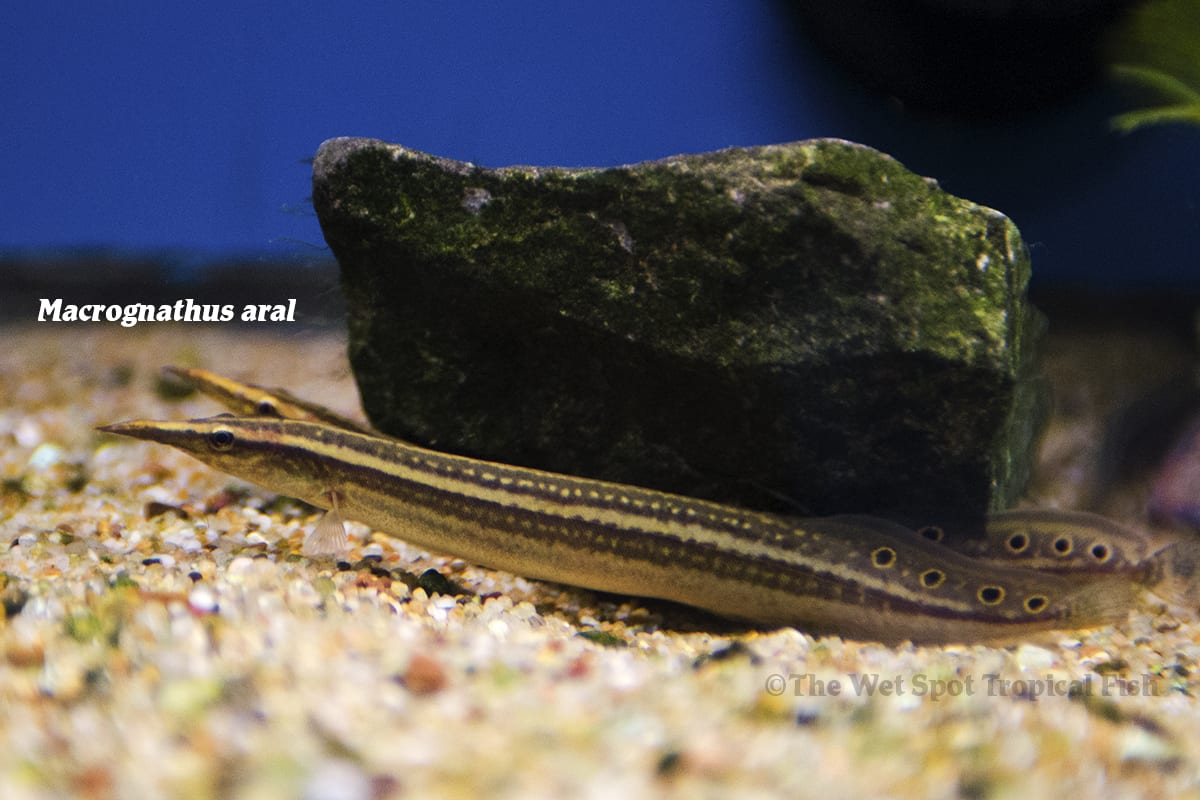Zooquarium
Zooquarium
Natural history repeats itself. Once successful traits arise in one organism, they tend to repeat across the animal kingdom from the deepest depths to the highest peaks. Even animals in different phyla can resemble each other. As a result, we aquarists have the opportunity to flex our zookeeper or safari adventurer muscles by curating tanks with fish resembling exotic terrestrial animals too wild to make good pets themselves. Look into your tank and observe zebras of the African plains, large cats of South American jungles, or exotic birds of Sri Lankan rain forests. Resembling our favorite exotic creatures are Botia striata, Lepidocephalichthys guntea, and Macrognathus aral.
Scientific NameBotia striata
Common NameZebra Loach
Temperature / pH69 to 79°F / 6.0 to 7.5 pH
Native LocationIndia
Preferred DietSmall invertebrates
‘Galloping’ across the rocky bottoms of the Tunga river in southern India are the brilliantly striped B. striata. Also known as “Zebra Loaches” these bottom dwellers reach about 3.5 inches in length and exhibit extensive black, white, and golden striping, and red mouth parts. Botiid loaches require well-developed tank setups with sand or fine gravel substrate, many water worn rocks, pebbles, and driftwood branches and roots. Lighting should remain subdued, and plants like ferns and mosses provide great furnishing, otherwise, decor is largely left to personal taste, so long as sharp edges are absent. Gregarious and mostly peaceful by nature, Zebra Loaches should be kept in conspecific groups of 6 or more, and do well in many community tanks. They do best alongside open-water dwelling species that aren’t spooked by their active swimming and exploring. Active explorers, they do have a tendency to jump ship, so make sure tanks have tight fitting lids. Unlike their herbivorous namesakes, these loaches are mostly carnivorous in the wild supplemented by soft aquatic plant vegetal matter. In captivity, they can be fed varied high-quality dried foods with frequent live and frozen offerings, and occasional fresh fruit and vegetable prepared foods. Tank waters should be maintained with temperatures between 69 and 79°F, pH of 6.0 to 7.5, and hardness between 18 and 179 ppm.
Scientific NameLepidocephalus guntea
Common NamePanther Loach
Temperature / pH68 to 77°F / 6.0 to 8.0 pH
Native LocationIndia
Preferred DietSmall invertebrates
‘Prowling’ the Ganges river systems of northern india is the cat-like L. guntea. Reaching about 3 inches in length, the “Panther Loach” is long-whiskered with dark bodies and faint spotting resembling jaguar panthers. These loaches are most often found lurking in shallow and slow moving backwaters and paddy fields with dense vegetation and muddy or silty substrate. In captivity, tanks should have soft substrate that allows them to burrow and dig into. Other decor can include water-worn rocks, driftwood, or anything else that provides a dark refuge. Gregarious and extremely peaceful by nature, they should be kept in conspecific groups of 4 or more, and can be housed alongside any fish hailing from similar environments. Hunting microfauna, these loaches gulp mouthfuls of substrate sifting out small crustaceans, insect larvae and other aquatic invertebrates, allowing sand and dirt to exit through their gill slits. They should be fed high quality sinking foods with regular supplementation of live and frozen delicacies. Panther loaches do best in tanks with water temperatures of 68 to 77°F, pH between 6.0 and 8.0, and hardness of 36 to 215 ppm.
Scientific NameMacrognathus aral
Common NameStriped Peacock Eel
Temperature / pH73 to 79°F / 6.5 to 7.5 pH
Native LocationSoutheast Asia
Preferred DietCanivorous
‘Strutting’ through brackish and stagnant waters of southeast Asia, is M. aral. Also known as ‘Striped Peacock Eels’, these spiny eels reach up to 7 inches in length, have pointed beak-like snouts, electric blue and dark striping, and peacock-like eyespots on their dorsal fins. Inhabiting still waters in the wild, they are best suited for tanks with soft-sandy substrate added after the rest of tank decor. Spiny eels dig and burrow through substate, and if it is too deep, you may go long periods without seeing the individuals. Additionally, they require many dark refuges made from piles of rocks, bogwood, or whatever the aquarist sees fit. Mostly peaceful, these spiny eels may gulp small fishes, though they can be kept well alongside other large, peaceful species. With a tendency toward territoriality, very large tanks with well defined territories formed by furnishings is required if more than one is to be kept. As nocturnal hunters of aquatic invertebrates, these peacock eels should be fed meaty foods like prawns, mussels, cockles, earthworms, and bloodworm. Optimal water conditions include temperatures between 73 and 79°F, pH of 6.5 to 7.5, and hardness of 35 to 107 ppm.
Have you always wanted exotic pets? Here at The Wet Spot, we offer the next best (or in our opinion, better) option.


